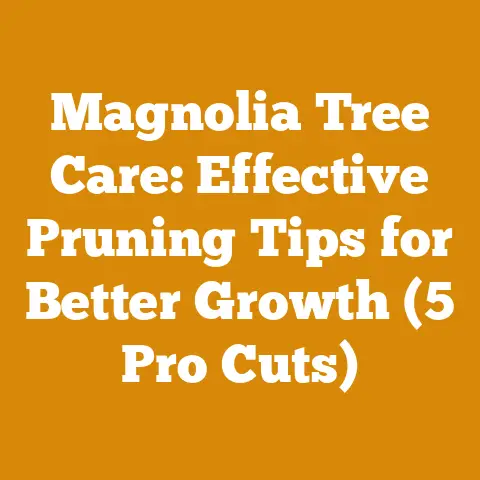Prop for Tree Stability (5 Expert Tips for Safe Wood Handling)
Introduction: The Hidden Health Benefits of Propping for Tree Stability
As someone deeply involved in the world of wood processing, logging, and firewood preparation for many years, I’ve learned that our work isn’t just about the wood itself. It’s also about the trees, their health, and their stability. Ensuring the safety and longevity of trees, especially those we value for their beauty, shade, or fruit, often requires a little extra support. This support, or “propping,” can seem like a simple act, but it’s an art and science that, when done right, provides significant health benefits, both for the tree and, indirectly, for us.
Working with trees and wood has taught me the profound connection between nature and well-being. The physical labor involved in propping trees, handling wood, and preparing firewood is a fantastic form of exercise. It builds strength, improves cardiovascular health, and boosts mental clarity. But beyond the physical aspect, there’s a therapeutic element to working with trees. The quiet focus required, the satisfaction of a job well done, and the connection to the natural world all contribute to a sense of peace and well-being.
In this guide, I’ll share my expertise on propping trees for stability, focusing on safe wood handling practices. I’ll provide expert tips that will help you ensure the health and safety of your trees and yourself. Let’s dive in!
Prop for Tree Stability: 5 Expert Tips for Safe Wood Handling
Trees, magnificent and resilient as they are, sometimes need a little help to stand tall, especially when faced with storms, heavy fruit loads, or structural weaknesses. Propping a tree involves providing external support to prevent it from leaning, breaking, or falling. This not only protects the tree itself but also safeguards people and property nearby.
1. Assessing the Need for Propping: A Tree’s Silent Plea
Before I even think about grabbing a saw or a support beam, the first thing I do is assess the tree itself. This is the most crucial step because not every leaning tree needs propping. Some trees naturally grow at an angle, and interfering with this natural growth can do more harm than good.
Identifying the Problem:
- Leaning: Is the tree leaning excessively, especially after a storm? Note the angle of the lean and whether it’s a recent development.
- Cracks or Splits: Are there any visible cracks or splits in the trunk or major branches? These are signs of structural weakness.
- Root Issues: Is there evidence of root rot, exposed roots, or soil erosion around the base of the tree?
- Heavy Fruit Load: Is the tree bearing an unusually heavy load of fruit, causing branches to sag dangerously?
- Weak Branch Unions: Are there V-shaped branch unions instead of U-shaped? V-shaped unions are weaker and more prone to breakage.
The Importance of Professional Consultation:
While I can often assess the situation myself, I always recommend consulting with a certified arborist, especially if the tree is large, valuable, or presents a complex situation. Arborists have the expertise to diagnose underlying problems and recommend the best course of action. I once spent a week propping a large oak tree, only to find out later from an arborist that the tree had an incurable fungal infection. The propping was a temporary fix, and the tree eventually had to be removed. This experience taught me the importance of getting a professional opinion before investing time and resources.
Data-Driven Assessment:
While visual inspection is crucial, I also use data to inform my decisions. For example, I might measure the lean angle using a clinometer or assess the soil moisture content to determine if root rot is a concern. I also keep records of past weather events, such as wind storms, to understand the tree’s history and vulnerability.
Takeaway: A thorough assessment is the foundation of successful tree propping. Don’t rush this step.
2. Choosing the Right Propping Materials: Strength and Stability
Once I’ve determined that a tree needs propping, the next step is to select the right materials. The choice of materials depends on the size and weight of the tree, the degree of support required, and the aesthetic considerations. I always aim for a balance of strength, durability, and visual appeal.
Common Propping Materials:
- Wooden Posts: These are a classic choice, especially for smaller trees. I prefer using pressure-treated lumber for its resistance to rot and insects. The diameter of the post should be proportional to the size of the branch or trunk it’s supporting. A good rule of thumb is to use a post that’s at least one-third the diameter of the branch.
- Metal Pipes: These are stronger than wooden posts and can be used for larger trees or branches. I often use galvanized steel pipes for their corrosion resistance. Again, the diameter of the pipe should be appropriate for the load it’s supporting.
- Cables and Ropes: These can be used to provide tension support, pulling a leaning branch back into position. I prefer using high-strength synthetic ropes, such as polyester or nylon, for their durability and resistance to stretching. Steel cables are also an option, but they can be more difficult to work with and can damage the tree if not properly installed.
- Concrete: Concrete can be used to create a solid base for the propping structure. I often use concrete to anchor wooden posts or metal pipes in the ground.
- Tree Straps and Padding: These are essential for protecting the tree from damage. Tree straps are wide, soft straps that distribute the pressure of the support over a larger area, preventing girdling or abrasion. Padding, such as burlap or foam, can be used to cushion the contact points between the support and the tree.
Material Specifications:
- Pressure-Treated Lumber: Look for lumber that’s treated to resist rot and insects. The treatment level should be appropriate for ground contact. I typically use lumber that’s treated to a retention level of 0.40 lbs/cu ft.
- Galvanized Steel Pipes: Choose pipes with a wall thickness that’s appropriate for the load they’ll be supporting. I often use Schedule 40 pipes for their strength and durability.
- Synthetic Ropes: Select ropes with a high tensile strength. I prefer using ropes with a breaking strength that’s at least five times the expected load.
- Tree Straps: Choose straps that are wide enough to distribute the pressure evenly. I typically use straps that are at least 2 inches wide.
My Go-To Material Combination:
For most propping projects, I find that a combination of wooden posts, concrete footings, and tree straps provides the best balance of strength, durability, and cost-effectiveness. I’ll set the wooden posts in concrete footings to provide a stable base, then use tree straps to attach the posts to the tree.
Takeaway: The right materials are crucial for providing effective and safe support.
3. Safe Wood Handling Techniques: Protecting Yourself and the Tree
Propping a tree involves working with wood, tools, and sometimes heavy materials. Safety is paramount. I always emphasize the importance of personal protective equipment (PPE) and safe work practices.
Essential PPE:
- Gloves: Protect your hands from splinters, abrasions, and cuts. I prefer using leather gloves for their durability and grip.
- Eye Protection: Wear safety glasses or a face shield to protect your eyes from flying debris.
- Hearing Protection: Use earplugs or earmuffs when operating power tools, such as chainsaws or drills.
- Hard Hat: Protect your head from falling branches or tools.
- Steel-Toed Boots: Protect your feet from falling objects and sharp objects on the ground.
- Long Pants and Sleeves: Protect your skin from scratches, insect bites, and exposure to the sun.
Safe Lifting Techniques:
- Bend your knees and keep your back straight.
- Keep the load close to your body.
- Avoid twisting your body while lifting.
- Get help if the load is too heavy.
- Use lifting aids, such as dollies or levers, when possible.
Safe Tool Handling:
- Use the right tool for the job.
- Keep your tools sharp and in good working condition.
- Follow the manufacturer’s instructions for operating power tools.
- Never use a power tool when you’re tired or distracted.
- Keep your work area clean and free of clutter.
- Be aware of your surroundings and the location of other people.
Protecting the Tree:
- Avoid damaging the bark when attaching supports. Use tree straps and padding to cushion the contact points.
- Don’t over-tighten the supports. Allow the tree to move naturally in the wind.
- Inspect the supports regularly and adjust them as needed.
- Remove the supports once the tree has regained its stability.
A Near Miss Story:
I once had a close call while propping a large apple tree. I was using a chainsaw to cut a wooden post when the chain snagged on a knot. The chainsaw kicked back violently, and I narrowly avoided being struck in the face. This experience reinforced the importance of wearing proper PPE and being extra careful when operating power tools.
Takeaway: Safety should always be your top priority when handling wood and tools.
4. Propping Techniques: A Step-by-Step Guide
Now that I’ve covered the basics of assessment, materials, and safety, let’s get into the actual propping techniques. There are several different methods for propping trees, and the best method depends on the specific situation.
Method 1: Simple Post Support
This is the most basic method and is suitable for smaller trees or branches that need minimal support.
- Prepare the Post: Cut the wooden post to the desired length. The length should be such that the post will support the branch at the desired height.
- Prepare the Base: Dig a small hole in the ground where the post will be placed. The hole should be deep enough to provide a stable base for the post. Consider using concrete to create a more permanent base. I usually dig a hole that’s about 12 inches deep and 12 inches in diameter, then fill it with concrete.
- Position the Post: Place the post in the hole and adjust it until it’s supporting the branch at the desired angle. Use a level to ensure that the post is plumb.
- Secure the Post: Backfill the hole with soil and tamp it down firmly. If you’re using concrete, pour it into the hole and allow it to cure according to the manufacturer’s instructions.
- Attach the Tree Strap: Wrap a tree strap around the branch and the post, and secure it tightly. Use padding to protect the bark from damage.
Method 2: Tension Support with Cables or Ropes
This method is used to pull a leaning branch back into position.
- Anchor the Cable or Rope: Attach one end of the cable or rope to a strong anchor point, such as another tree or a ground anchor. Make sure the anchor point is strong enough to withstand the tension.
- Attach the Cable or Rope to the Branch: Wrap the cable or rope around the branch that needs support, and secure it tightly. Use padding to protect the bark from damage.
- Tighten the Cable or Rope: Gradually tighten the cable or rope until the branch is pulled back into the desired position. Use a turnbuckle or a come-along to make it easier to tighten the cable or rope.
- Secure the Cable or Rope: Once the branch is in the desired position, secure the cable or rope to prevent it from slipping.
Method 3: Multi-Post Support System
This method is used for larger trees or branches that require more extensive support.
- Plan the Layout: Determine the number and placement of the posts. The posts should be spaced evenly around the tree or branch to provide balanced support.
- Prepare the Posts and Bases: Prepare the posts and bases as described in Method 1.
- Position and Secure the Posts: Position and secure the posts as described in Method 1.
- Connect the Posts to the Tree: Use tree straps and padding to connect the posts to the tree or branch. Distribute the straps evenly to avoid putting too much pressure on any one point.
Case Study: Propping a Historic Apple Tree
I was once called in to help prop a historic apple tree that was over 100 years old. The tree had several large, heavy branches that were leaning precariously close to the ground. We used a multi-post support system to provide the necessary support. We carefully positioned the posts to avoid damaging the roots and branches, and we used tree straps and padding to protect the bark. The project took several days to complete, but the result was a stable and healthy tree that could continue to bear fruit for many years to come.
Takeaway: Choose the propping method that’s best suited for the specific situation.
5. Monitoring and Maintenance: Ensuring Long-Term Stability
Propping a tree is not a one-time fix. It requires ongoing monitoring and maintenance to ensure long-term stability. I always tell people that propping is like caring for a patient; you can’t just set the support and walk away.
Regular Inspections:
- Check the supports for signs of damage or wear. Look for cracks, splits, rot, or corrosion.
- Inspect the tree straps for signs of fraying or loosening.
- Monitor the tree for signs of stress or disease. Look for wilting leaves, discolored bark, or insect infestations.
- Check the soil around the base of the tree for signs of erosion or compaction.
Adjustments and Repairs:
- Tighten or replace tree straps as needed.
- Repair or replace damaged supports.
- Adjust the position of the supports as the tree grows.
- Add additional supports if the tree becomes heavier or more unstable.
- Address any underlying health issues, such as root rot or insect infestations.
Removing the Supports:
The goal of propping is to provide temporary support until the tree can regain its stability on its own. Once the tree has developed a stronger root system or the branch has strengthened, the supports can be removed.
- Gradually reduce the amount of support over time.
- Remove the supports completely once the tree is stable.
- Monitor the tree closely after removing the supports to ensure that it remains stable.
A Lesson Learned:
I once removed the supports from a young maple tree too soon, and the tree promptly leaned over again. I had to reinstall the supports and wait another year before the tree was strong enough to stand on its own. This experience taught me the importance of patience and careful monitoring.
Metrics for Success:
- Lean Angle: Measure the lean angle of the tree before and after propping. The goal is to reduce the lean angle to a safe level.
- Support Stability: Assess the stability of the supports. The supports should be able to withstand wind and other environmental factors.
- Tree Health: Monitor the health of the tree. The tree should show signs of improved health, such as increased leaf growth and reduced stress.
Takeaway: Ongoing monitoring and maintenance are essential for ensuring the long-term stability of the tree.
Conclusion: The Art and Science of Tree Propping
Propping trees for stability is a blend of art and science. It requires careful observation, sound judgment, and a commitment to safety. It’s not just about preventing a tree from falling; it’s about preserving its health, beauty, and value. By following the expert tips I’ve shared, you can confidently tackle propping projects and ensure the well-being of your trees and yourself. Remember to prioritize safety, choose the right materials, and monitor your work regularly. With a little effort and attention, you can help your trees stand tall for years to come.






